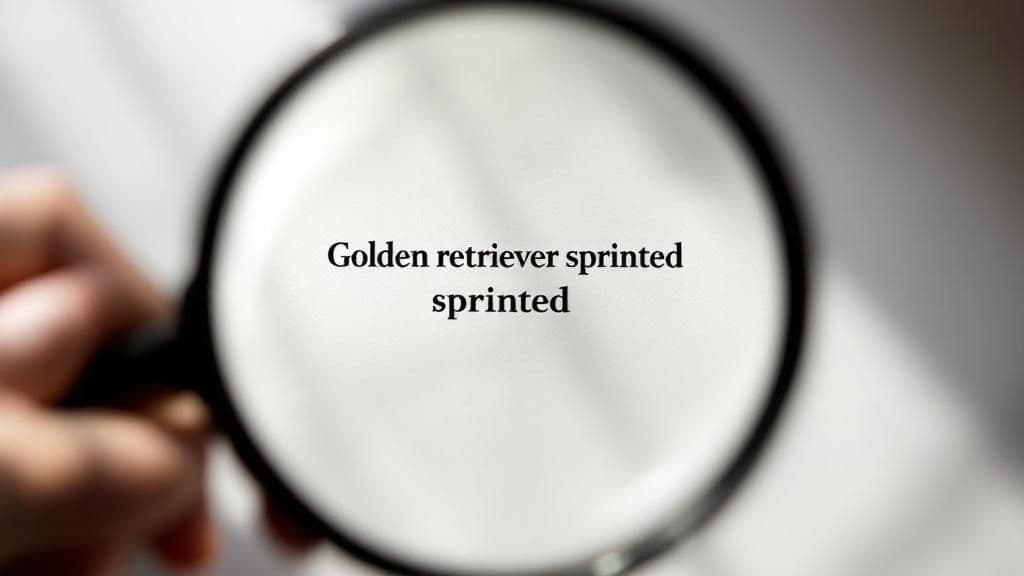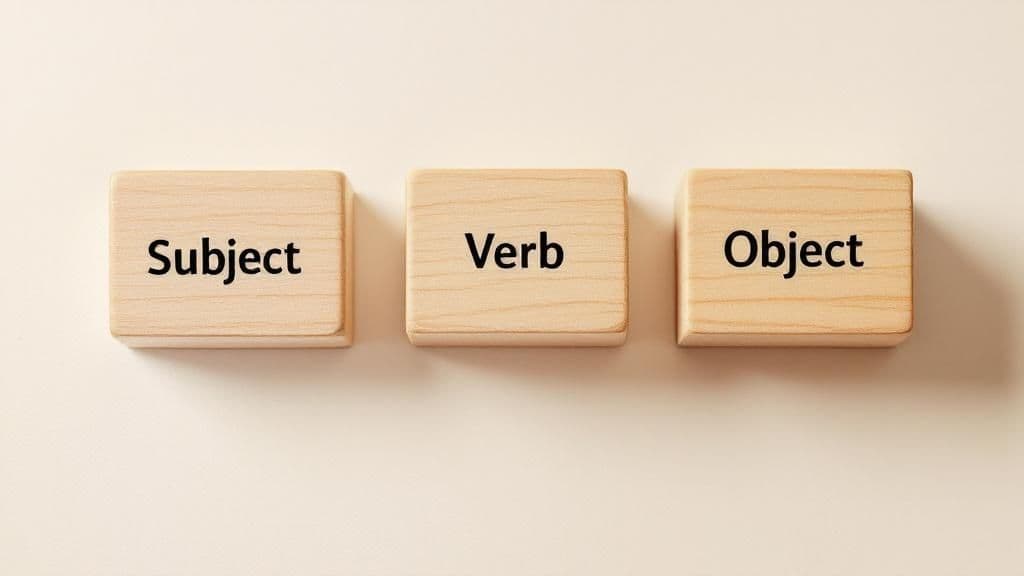8 Essential Tips for Clear Writing That Actually Work (2025)
Struggling with fuzzy prose? Discover our top tips for clear writing. Learn to use active voice, cut fluff, and structure sentences for maximum impact.

In a world overflowing with content, clarity is your superpower. It’s the difference between a message that gets ignored and one that inspires action. Whether you’re a solopreneur crafting a landing page, a freelance marketer writing a client proposal, or a creator building a personal brand, making your point clearly and quickly is essential. But "clear writing" often sounds like vague advice, a nice-to-have skill without a clear path to get there.
Forget the generic tips you've heard before. We’re diving deep into eight specific, actionable strategies that will immediately sharpen your prose. These aren't just rules; they're powerful techniques designed to make your ideas resonate and stick with your audience. Think of this as your practical toolkit for crafting messages that are impossible to misunderstand. While this article focuses on the foundational tips for clear writing, you can also explore other methods to make your work stand out. For a deeper dive into techniques that help elevate your content and achieve maximum impact, explore these 8 Effective Writing Strategies to add even more tools to your arsenal.
By the end of this guide, you won't just know what to do; you'll know how to do it. Ready to cut through the noise? Let’s get started.
1. Use Active Voice
If you want to instantly make your sentences punchier and easier to follow, this is the one change that delivers the biggest impact. Using the active voice means putting the "doer" of the action at the front of the sentence. It’s a simple switch that transforms weak, indirect prose into strong, direct communication. This is one of the most fundamental tips for clear writing, championed by literary greats from George Orwell to William Zinsser for a reason: it works.

When a subject acts, the sentence feels dynamic. When a subject is acted upon (passive voice), the energy drains away, and the meaning can become murky.
- Passive: The new feature was launched by our development team.
- Active: Our development team launched the new feature.
See the difference? The active version is shorter, more direct, and carries more authority. It answers the question "who did what?" immediately.
How to Spot and Fix Passive Voice
Finding passive voice in your own writing becomes second nature with practice. Here’s a quick-start guide:
- Look for "to be" verbs: Scan your sentences for words like is, am, are, was, were, be, being, and been followed by a past-tense verb (e.g., "was completed," "is managed").
- Identify the doer: Ask yourself, "Who or what is actually performing the action?" If the doer is missing or tacked on at the end with the word "by," you've likely found a passive sentence.
- Restructure the sentence: Move the doer you identified to the subject position at the beginning of the sentence and make them perform the verb.
When is passive voice okay? Reserve passive voice for specific situations, such as when the actor is unknown, irrelevant, or you intentionally want to de-emphasize them. For example, "Mistakes were made" is a classic passive construction used to avoid assigning blame. For most business and content writing, however, active voice is your best friend.
2. Eliminate Unnecessary Words
This is the secret to making every word count. Antoine de Saint-Exupéry famously said, “Perfection is achieved not when there is nothing more to add, but when there is nothing left to take away.” This principle is a cornerstone of clear writing. By trimming redundant phrases and filler words, you make your message tighter, more impactful, and respectful of your reader's time.

Verbose writing forces readers to work harder to find the core message. Concise writing delivers it directly. The imperative to eliminate unnecessary words is particularly evident in contexts demanding brevity, like learning how to add subtitles to a video, where conciseness directly impacts readability.
- Wordy: Due to the fact that the deadline is approaching, we need to work faster.
- Concise: Because the deadline is approaching, we need to work faster.
The concise version says the same thing with fewer words, making it sharper and easier to process.
How to Cut the Fluff
Pruning your prose is a skill that sharpens with practice. Here’s how to start trimming the fat from your sentences:
- Hunt for wordy phrases: Look for common culprits like "in order to," "at this point in time," or "for the purpose of." Replace them with single, stronger words like "to," "now," or "for."
- Read it aloud: Your ears will often catch awkward phrasing and unnecessary words that your eyes miss. If a sentence sounds clunky or unnatural, it probably needs a trim.
- Simplify prepositional phrases: Chains of prepositions (e.g., "the opinion of the members of the board") can often be simplified. Try "the board members' opinion" instead.
Why less is more Every extra word you cut makes the remaining words more powerful. This isn't just about being brief; it's about being effective. Tight, clean copy is more persuasive, more professional, and ultimately, more likely to be read and understood. It’s one of the most vital tips for clear writing you can implement today. To speed up this process, you can find more information about using an AI text enhancer.
3. Write with Specific, Concrete Language
If you want your readers to see what you see and feel what you mean, stop speaking in vague generalities. Using specific, concrete language grounds your writing in reality, replacing fuzzy concepts with tangible details. This technique is one of the most powerful tips for clear writing because it closes the gap between your idea and the reader’s understanding, making your message memorable and impactful.

Abstract words force the reader to do the heavy lifting, while concrete words paint a picture for them. Specificity builds trust and authority by showing you have a command of the facts.
- Vague: Our product saw significant growth last quarter.
- Specific: Our new user sign-ups increased by 23% in Q3.
The specific version isn’t just clearer; it’s more credible and persuasive. It replaces a weak claim with verifiable proof.
How to Be More Specific
Making your language more concrete is a habit you can build by paying attention to your word choices. Here’s how to start:
- Replace vague nouns: Hunt down words like thing, stuff, aspects, and situation. Replace them with the exact noun. Instead of "We need to handle this situation," try "We need to resolve this client's billing error."
- Quantify when possible: Use numbers, data, and measurements to add precision. "The server is faster" becomes "The server's page load time decreased from 3.2 to 1.1 seconds."
- Choose vivid verbs: Don't just say a dog ran. Did it sprint, trot, scamper, or bound? Each verb creates a distinctly different mental image.
Why this matters for every writer Whether you're a developer writing documentation, a marketer creating a landing page, or a founder emailing an investor, specificity is your ally. Precise language, popularized in journalism and championed by writers like Joan Didion, eliminates ambiguity and demonstrates expertise. It ensures everyone is on the same page, which is the ultimate goal of clear communication.
4. Use Simple Sentence Structure
If your goal is to be understood without friction, embracing simplicity is your secret weapon. Using a simple sentence structure means prioritizing straightforward subject-verb-object patterns and steering clear of convoluted clauses that can confuse your reader. This approach, championed by masters of prose like Ernest Hemingway and modern UX writers at companies like Apple, ensures your message lands with clarity and impact. It’s a foundational tip for clear writing that makes your work accessible to everyone.

A complex sentence forces the reader to work hard, untangling clauses just to find the main point. A simple sentence delivers the idea directly, without any extra cognitive load.
- Complex: Although our new software has many advanced features that were developed over a long period, which are designed to help users, it remains surprisingly easy to use.
- Simple: Our new software has many advanced features. Despite its power, it’s surprisingly easy to use.
The second version uses two short, direct sentences. The meaning is identical, but the delivery is cleaner and more confident, making the information much easier to digest.
How to Simplify Your Sentences
Building the habit of writing simply requires a conscious effort to trim the excess and focus on the core message. Here’s how you can start today:
- Break it down: When you find a long, winding sentence, split it into two or more shorter ones. Each sentence should contain just one main idea.
- Lead with the point: Place the most important information, the main subject and verb, at the beginning of the sentence. Don’t make your reader wait for the payoff.
- Read it aloud: This is the ultimate test. If you stumble or run out of breath while reading a sentence, it’s a clear sign that it needs to be simplified.
When is complexity okay? Variety is still important in writing. A mix of sentence lengths can create a pleasing rhythm. However, complexity should be a deliberate stylistic choice, not a default setting. For most professional and online content where clarity is king, simplicity should be your guiding principle. Start simple, and only add complexity when it truly serves a purpose.
5. Lead with Your Main Point
In a world of shrinking attention spans, getting your key message across quickly isn't just a courtesy; it's a necessity. This is where leading with your main point, a cornerstone of effective communication, comes into play. It means putting the most critical information right at the beginning of your sentences, paragraphs, and entire documents. This "front-loading" technique respects your reader's time and ensures your message lands, even if they only skim the first few lines. This is one of the most powerful tips for clear writing, borrowed from journalism and perfected for modern business.
This method, often called the inverted pyramid, flips the traditional "build-up to a conclusion" model on its head. Instead of saving the best for last, you give it away immediately.
- Burying the lead: After analyzing Q3 performance metrics and cross-referencing them with our new marketing initiatives, we've concluded that we need to increase our social media ad budget.
- Leading with the point: We need to increase our social media ad budget because our Q3 analysis shows it's our most effective marketing channel.
The second version is instantly understandable. The reader gets the "what" and "why" immediately, making the communication far more efficient and impactful.
How to Front-Load Your Message
Training yourself to lead with the conclusion can feel unnatural at first, but it quickly becomes a powerful habit for clear and persuasive writing.
- Write the topic sentence first: Before you write a paragraph, summarize its entire point in a single, clear sentence. Make that your first sentence. Everything else that follows should only support or expand on that initial statement.
- Think like a journalist: Ask yourself, "What is the single most important piece of information my reader needs to know?" Start with that. Then, provide the next most important details, and so on.
- Use clear email subjects: Don't use vague subjects like "Update" or "Question." Instead, lead with the point: "Decision Needed: Q4 Budget Proposal" or "Feedback Required: Draft of Client Report." This allows the recipient to prioritize their response effectively.
Why this works so well for digital content On a screen, readers often scan rather than read word-for-word. Placing key information "above the fold"-the visible area without scrolling-is crucial. By leading with your main point, you guarantee that even the most hurried skimmers will grasp your core message. This principle is fundamental to improving your communication skills. You can learn more about other impactful writing techniques on typeboost.ai.
6. Use Parallel Structure
If you want your writing to feel balanced, professional, and easy to read, mastering parallel structure is key. This technique involves using the same grammatical pattern for items in a series, comparison, or list. It creates a satisfying rhythm that helps your reader's brain process information smoothly and is a cornerstone of powerful, persuasive writing. This is one of those subtle tips for clear writing that, once you see it, you can't unsee.
When sentence elements are parallel, they flow logically. When they are not, the sentence can feel clunky and disjointed, forcing your reader to stop and untangle the meaning.
- Not Parallel: Our new process helps with saving time, improved accuracy, and to reduce costs.
- Parallel: Our new process helps with saving time, improving accuracy, and reducing costs.
The parallel version feels more polished and is instantly easier to understand. The brain expects the pattern (-ing, -ing, -ing) and isn't thrown off by a sudden switch in form.
How to Spot and Fix Faulty Parallelism
Developing an ear for parallelism makes your editing process much more effective. Here's a quick guide to get you started:
- Check your lists: Whether you're using bullet points or an in-sentence list, ensure every item starts with the same type of word (e.g., all nouns, all verbs in the same tense, or all "-ing" words).
- Read it aloud: Your ears are great at catching awkward phrasing. If a list or comparison sounds "off" when you say it, there's a good chance the structure is not parallel.
- Look at headings: For maximum clarity, headings and subheadings within the same section should follow a consistent grammatical pattern (e.g., start each with a verb).
Where does this come from? Parallel structure has roots in classical rhetoric and oratory. It’s the secret sauce behind some of history's most memorable lines, from Martin Luther King Jr.'s "I have a dream..." refrains to iconic company mission statements like "To innovate, inspire, and impact." It’s a powerful tool for making your ideas stick.
7. Choose Strong Verbs Over Adverbs
If you want to inject energy and precision into your sentences, this is a game-changer. Choosing a strong verb over a weak verb-adverb combination makes your writing more vivid and impactful. It’s the difference between telling your reader what happened and showing them. This advice, famously championed by authors like Stephen King, is a core principle of dynamic prose and one of the most effective tips for clear writing.
A powerful verb does the heavy lifting on its own, conveying action and emotion in a single word. When you lean on adverbs (especially those ending in "-ly") to prop up a weak verb, your sentences often become clunky and less direct.
- Weak: The CEO spoke angrily about the quarterly results.
- Strong: The CEO ranted about the quarterly results.
The strong verb "ranted" is more concise and paints a much clearer picture than "spoke angrily." It's an instant upgrade in clarity and style.
How to Find and Replace Weak Verbs
Strengthening your verbs is a simple editing habit that pays huge dividends. It trims unnecessary words and makes your message resonate more powerfully with your audience.
- Hunt for "-ly" adverbs: During your editing pass, search your document for words ending in "-ly." These often signal a weak verb that can be replaced.
- Challenge the verb: When you find a verb-adverb pair, ask yourself: "Is there a single, more precise verb that captures this entire idea?"
- Use a thesaurus (thoughtfully): Don't just pick the first synonym. Look for a verb that perfectly fits the context and tone you want to achieve. Instead of "walked quickly," consider "rushed," "hurried," "darted," or "scrambled," depending on the specific situation.
When are adverbs okay? The goal isn't to eliminate every adverb from your writing. Adverbs are essential when they provide necessary information that the verb cannot convey on its own (e.g., "The new software update was launched globally"). The key is to avoid using them as a crutch for lazy, imprecise verbs. For most professional and creative writing, a strong verb is almost always the better choice.
8. Edit Ruthlessly
Great writing isn't written; it's rewritten. Ruthless editing is the disciplined process of transforming a rough first draft into a polished, impactful final piece. This isn't about just fixing typos; it's a multi-pass system where you look at your work from different angles, continuously refining the structure, clarity, and word-level precision. This approach is a cornerstone of professional publishing, championed by everyone from newspaper editors to authors like Anne Lamott, who famously wrote about the necessity of "shitty first drafts."
The first draft is for getting ideas down. The editing process is where you apply the critical thinking that leads to clear writing. It’s where you cut the fluff, sharpen your arguments, and ensure every word serves a purpose. Ernest Hemingway famously rewrote the ending to A Farewell to Arms 39 times to get it just right.
- First Draft: This marketing report which I have prepared for the team contains a detailed analysis of our key performance indicators from the last quarter, which were quite interesting.
- Edited: This report analyzes our Q3 key performance indicators.
The edited version is concise, direct, and professional. It respects the reader's time by getting straight to the point.
How to Edit with a Purpose
Adopting a ruthless editing mindset means being willing to kill your darlings-phrases or sentences you love but that don't serve the reader. Here’s how to do it effectively:
- Let it cool off: Step away from your draft for a few hours or even a day. Coming back with fresh eyes helps you spot awkward phrasing and logical gaps you missed earlier.
- Edit in passes: Don't try to fix everything at once. Do one pass for big-picture structure and flow. Do another for sentence clarity and conciseness. A final pass can be for grammar and spelling.
- Read it aloud: Your ears will catch what your eyes miss. Reading your text out loud helps you identify clunky sentences, poor rhythm, and unnatural phrasing.
- Create more time for editing: Effective editing is crucial for clear writing, and optimizing your drafting process can give you more time for it. You can boost your writing productivity with speech-to-text to streamline your initial writing efforts.
Why be so ruthless? Your goal is to communicate an idea as clearly and efficiently as possible. Every unnecessary word, confusing sentence, or poorly structured paragraph is a barrier between your message and your reader. Ruthless editing removes those barriers, ensuring your ideas land with maximum impact. For more in-depth strategies, learn more about editing tips for writers on Typeboost.ai.
Clear Writing Tips Comparison Table
| Principle | Implementation Complexity 🔄 | Resource Requirements ⚡ | Expected Outcomes 📊 | Ideal Use Cases 💡 | Key Advantages ⭐ |
|---|---|---|---|---|---|
| Use Active Voice | Low - straightforward sentence restructuring | Low - mainly rewriting effort | Clear, direct, engaging sentences; improved clarity | General writing, persuasive texts, reports | More engaging; assigns clear responsibility; concise writing |
| Eliminate Unnecessary Words | Moderate - requires careful judgment | Low - focused editing time | Tighter, more efficient prose; enhanced clarity | Professional, business writing, product descriptions | Saves reader time; polished, powerful writing |
| Write with Specific, Concrete Language | Moderate - research and detail gathering | Moderate - time to find specifics | Vivid, memorable communication; reduces ambiguity | Technical, journalistic, instructional writing | Engages readers; builds credibility |
| Use Simple Sentence Structure | Low - follows basic grammar patterns | Low - easy to apply | Improved comprehension; easier translation | Broad audiences, legal, technical documents | Reduces cognitive load; fewer errors |
| Lead with Your Main Point | Low - requires structural awareness | Low - mostly planning and editing | Immediate reader attention; better information retention | Journalism, business reports, marketing content | Captures attention; improves scannability |
| Use Parallel Structure | Moderate - requires syntax alignment | Low - editing and revision effort | Balanced, rhythmic prose; easier to follow lists | Speeches, advertising, formal writing | Enhances flow and professionalism |
| Choose Strong Verbs Over Adverbs | Moderate - vocabulary enhancement needed | Moderate - editing and vocabulary work | Dynamic, vivid writing; reduced wordiness | Creative writing, sports reporting, fiction | More engaging; stronger imagery |
| Edit Ruthlessly | High - multiple, focused editing passes | High - time and effort intensive | Polished, professional final product; error-free content | All serious writing requiring high quality | Dramatically improves quality; strengthens clarity |
Make Clarity Your Default Setting
We’ve journeyed through eight foundational pillars of clear writing, from the power of the active voice to the necessity of ruthless editing. It's a lot to take in, but remember this: clarity isn't about memorizing rigid rules. It's about building a new set of creative instincts. It’s about training your brain to see the most direct path from your idea to your reader's understanding.
Think of it like developing a new muscle. At first, cutting unnecessary words or restructuring a sentence to lead with the main point feels clunky and slow. You have to consciously stop, analyze, and rewrite. But with consistent practice, these techniques stop being chores and start becoming your default setting. The goal is to make these tips for clear writing so ingrained that you apply them automatically, without even thinking.
From Theory to Daily Practice
The real challenge isn't understanding these concepts; it's applying them consistently, especially when you're under pressure or deep in a creative flow. How do you shift from knowing you should use strong verbs to actually doing it every single time? This is where intentional practice transforms into lasting skill.
To start making this shift today, try this simple exercise:
- Pick one principle a week. For the next seven days, focus solely on eliminating unnecessary words. Scrutinize every email, every report, every social media post. Ask yourself, "Can I say this with fewer words?"
- The following week, target passive voice. Use a search function (Ctrl+F) in your documents to find instances of "is," "was," "were," and "by" to hunt down passive constructions and flip them into active ones.
- Continue this cycle through all the tips, from using concrete language to strengthening your verbs.
This focused, one-at-a-time approach prevents you from feeling overwhelmed and helps you internalize each skill until it becomes second nature.
Why This Effort Is Worth More Than You Think
Mastering clear writing does more than just make your sentences pretty. It fundamentally changes how you are perceived. When your writing is clear, your thinking appears clear. You build trust faster with clients, persuade stakeholders more effectively, and connect more deeply with your audience. Your ideas, no longer trapped behind a wall of jargon and convoluted phrasing, can finally land with the impact they deserve.
You've already taken the most important step by seeking out these tips for clear writing. You recognize that clarity is a superpower in a world noisy with confusion. Now, the journey is about turning that knowledge into a consistent, powerful habit. Don’t strive for perfection on day one. Strive for progress. Each trimmed sentence, each strengthened verb, and each clarified point is a victory that moves you closer to becoming a truly effective communicator. Your ideas are worth it.
Ready to turn these principles into effortless habits? TypeBoost integrates directly into your existing workflow, allowing you to apply custom prompts like "Rewrite for clarity" or "Trim unnecessary words" with a simple keyboard shortcut. Stop switching between apps and start making clear writing your default setting by trying TypeBoost today.